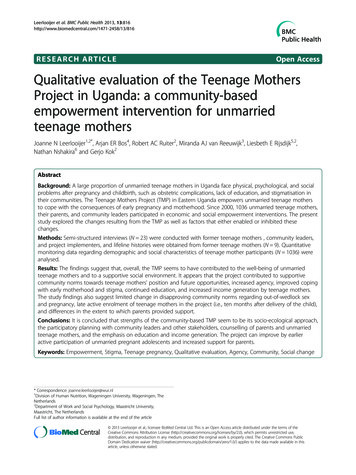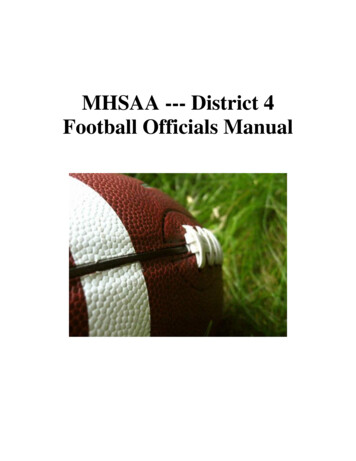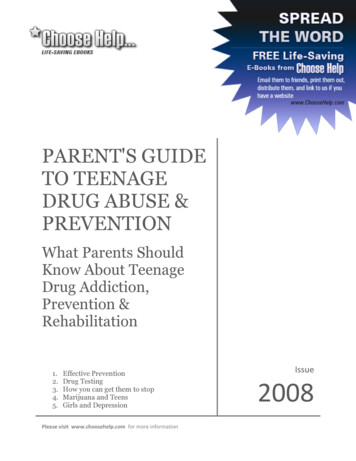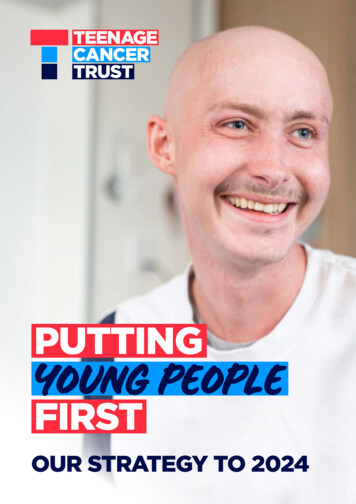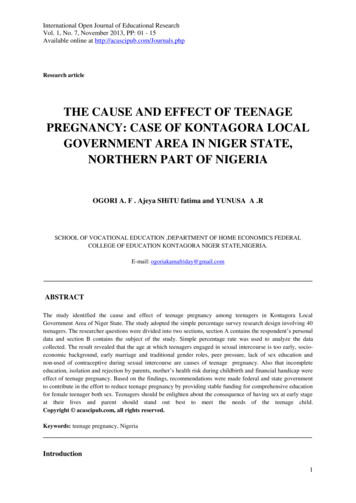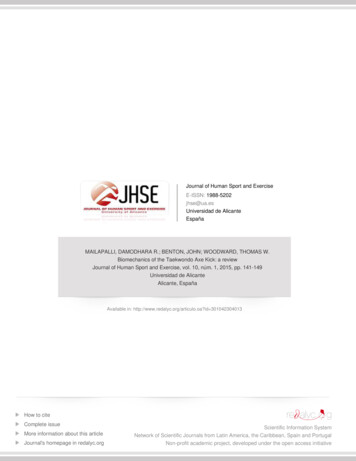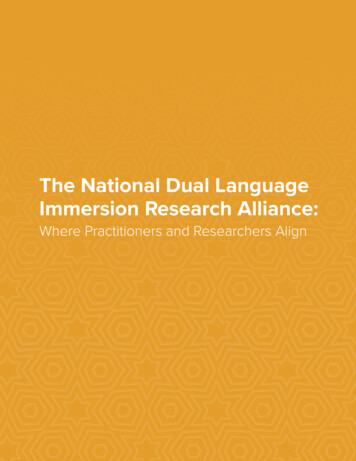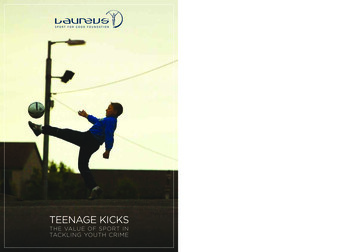
Transcription
TEENAGE KICKSTHE VALUE OF SPORT INTACKLING YOUTH CRIME
TEENAGE KICKS THE VALUE OF SPORT IN TACKLING YOUTH CRIMEA MESSAGE FROM LAUREUS WORLD SPORTS ACADEMY MEMBER DALEY THOMPSONʻʻIt never ceases to amaze methat sport, something sosimple that so many of ustake for granted, can havesuch a powerful impact onself esteem and confidence.ʻʻ02A MESSAGE FROMDALEY THOMPSONLAUREUS WORLD SPORTS ACADEMY MEMBERWe all know that sport is great. It makes us physically fitter,stronger and healthier; it is fun, sociable and, almost withoutus knowing, it has the ability to make us more confident,resilient and happy. Few would argue against these benefits.However, what seems to be harder to accept is the potentialthat the power of sport has to create real and lasting socialchange. Despite evidence to the contrary, sport continues tobe viewed by the majority as a nice-to-have rather than aneffective mechanism to overcome some of the most pressingsocial challenges faced by individuals and communities allover the world. Whilst it is important to invest in sport forentertainment and leisure purposes, it is equally important torecognise and invest in sport as a mechanism for socialchange. At the moment, this is not being done nearly enough.As a professional athlete and Academy Member for theLaureus Sport for Good Foundation, I have been lucky enoughto experience the full potential of sport. During my career as adecathlete, I experienced firsthand, the maximum benefits ofsport – both physical and mental. Not only this, but I trulybelieve that the lessons I learnt during my sporting career –teamwork, leadership, respect, determination and friendship –have given me the personal strength and resilience to facedown any challenges and obstacles that have come my way.My role as Academy Member for the Laureus Sport for GoodFoundation has given me the opportunity to see the widerpotential of sport. I have visited projects in some of thepoorest and most deprived pockets of the world and seenwith my own eyes how sport is transforming young lives,breaking down barriers and bringing people together.Last year, during my cycle ride from Manchester to London forthe Foundation, I visited 8 inspiring projects that use sport tochange the lives of young people in the UK. One of them,Fight for Peace, a Laureus grantee in the heart of London’sEast End, encourages young people at risk of becominginvolved in gang violence or youth crime to channel theirenergy into constructive sports activities such as boxing andmartial arts. The young people taking part have theopportunity to transform their aggression into positive energy,learning teamwork, discipline and growing in self-confidencealong the way. It gives them an alternative to fighting in thestreet and shows them that it is possible to gain status andrespect without brandishing a weapon. It never ceases toamaze me that sport, something so simple that so many of ustake for granted, can have such a powerful impact on selfesteem and confidence, enabling young people to flourishand achieve their aspirations and dreams, and setting themon a good path in life.LAUREUS ACADEMY MEMBERS HUGO PORTA AND DALEY THOMPSON PAST BIG BEN WITHPRIME MINISTER DAVID CAMERON ON THE BREAKING THE CYCLE OF VIOLENCE BIKE RIDEwww.laureus.comwww.sportforgood.org03
TEENAGE KICKS THE VALUE OF SPORT IN TACKLING YOUTH CRIMEA MESSAGE FROM LAUREUS WORLD SPORTS ACADEMY MEMBER DALEY THOMPSONThis report assesses the economic value of three sportsprojects aimed at tackling gang violence and youth crime inthe UK. Each project is using sport to reach out to and engageyoung people at different stages along the criminal pathway.The results of the study clearly demonstrate that sport is notonly a successful mechanism; it is also a cost-effective way totackle the problem of youth crime and gang violence.Take the Boxing Academy in Tottenham, which is a sportsbased alternative to ‘Pupil Referral Units’ (centres for childrenwho are not able to attend a mainstream or special school).The ethos of the Academy is to instil discipline and respectthrough the experience of structured physical activity, sharedgoals and positive peer groups. It works in partnership withother youth support and social welfare organisations in thearea and there are a number of local mentors and role modelsin the coaching team. Our new report found that youngpeople attending this project are more likely to achievequalifications than their peers in Pupil Referral Units, and lesslikely to reoffend. What’s more, the Boxing Academy costshalf as much to run as a traditional Pupil Referral Unit, despiteachieving better results.LAUREUS AMBASSADOR WLADIMIR KLITSCHKO WITH PARTICIPANTS FROM FIGHT FOR PEACE PROJECT IN LONDONOne of the reasons that sport is so effective is due to the factthat it can provide an alternative structure and context foryoung people who would otherwise be attracted bypotentially negative social pursuits. The report, Breaking theCycle of Violence, which I delivered to Downing Street withmy fellow Academy Members last year, articulates how sportsinitiatives could make this happen. The key lies in thesimilarities of sport and gangs; both provide a sense ofbelonging, status and excitement. But, whilst sport also helpsyou develop control over your emotions and learn to respectcertain boundaries, being in a gang can be much moredestructive and sometimes even fatal. By using thisknowledge and working with existing hierarchies of the gang,involving suitable and realistic role models and ensuring thatthe project is firmly rooted within the local community, thereport demonstrated the possibility of reaching out to youngwww.laureus.compeople through sport and putting an end to the gangviolence and youth crime that have become so commonin societies today. This approach applies as much toyoungsters involved in gangs on the streets of London,as it does to the young gangs in the Favelas in Brazil – theprinciples are universal.However, we knew that the Breaking the Cycle of Violencereport on its own was not enough – a more robust approachand evidence base was needed to take the campaign thatstep further. Therefore I am really pleased to say that thisnew report, produced by the Laureus Sport for GoodFoundation in collaboration with New Philanthropy Capital,does just that. On average, it shows that sports-basedinitiatives tackling youth crime in the UK, pay back yourinvestment 5 times over!In a time of austerity, where countries all over the world aretaking measures to reduce spending and strengthen theireconomies, who can argue with a solution that has not onlybeen shown to work, but also saves money.Our challenge is for governments to recognise that theoutcomes of sport initiatives go beyond the more obviousphysical and mental benefits. We are calling for the HomeOffice and other government departments, who deal withyouth crime each and every day of the year, to recognise thatsport can provide an effective social framework for tacklingthe issue. In particular, we would like to see much moreevidence of sport being integrated into policy objectives aspart of the solution to urban youth gang violence and crime.DAVID CAMERON JOINS IN THE ACTION AT LILLIAN BAYLISS SCHOOLʻʻThe results of the studyclearly demonstrate thatsport is not only a successfulmechanism; it is also acost-effective way totackle the problem of youthcrime and gang violence.ʻʻ04THIS REPORT HAS BEENRESEARCHED ANDCO-WRITTEN BY NEWPHILANTHROPY CAPITALBy working together and realising the potential power ofsport, we can break the cycle of violence in the UK onceand for all.DALEY THOMSONLaureus World Sports Academy Memberwww.sportforgood.org05
TEENAGE KICKS THE VALUE OF SPORT IN TACKLING YOUTH CRIMESUMMARYʻʻʻʻOne of the most successfuland innovative ways to tacklecrime is to use sport to engageyoung people and createopportunities for them.SUMMARYYouth crime and antisocial behaviour cost government at least 4bn a year.1 One in five young people reports being involvedin crime and antisocial behaviour,2 and there are around75,000 new entrants into the youth justice system every year.3Youth crime is clearly an enormous problem, but it is notwithout solutions. One of the most successful and innovativeways to tackle crime is to use sport to engage young peopleand create opportunities for them.Sport has benefits for everyone, but it can be a particularlypowerful tool for tackling youth crime, helping to engagedisadvantaged and disillusioned young people who are hardto reach in other ways. There are plenty of stories of sportkeeping young people off the streets and out of trouble,engaging them in education, and inspiring them to get backon track. However, hard evidence is lacking, and it is difficult tomake a convincing case for investment in sports projects.THE ECONOMIC CASEMeasuring the outcomes of sports projects and comparing thecosts of problems and solutions can provide valuable insightsinto what is effective. This report applies economic analysis tothree projects that use sport in different ways to tackle crime:Kickz, The Boxing Academy and 2nd Chance.Sports projects aimed at tackling youth crime can provideexcellent value for money. The three projects we look atprovide financial savings to society by reducing costs to thecriminal justice system, as well as creating value forcommunities by reducing costs to the victims of crime andimproving the life chances of young people.ʻʻʻʻ06One in five youngpeople reports beinginvolved in crime andantisocial behaviour.www.laureus.comA GIRLS EVENT AT THE ARSENAL KICKZPROJECT AT ELTHORNE PARKLOCAL CHILDREN PARTICIPATE IN A WORKOUTSESSION AT THE BOXING ACADEMY2ND CHANCE TRAINING SESSIONKICKZTHE BOXING ACADEMY2ND CHANCEKickz is a national programme, funded by the PremierLeague and Metropolitan Police, that uses football to workwith hard-to-reach young people in deprived areas. ArsenalFC delivers Kickz in Elthorne Park, north London, and theproject has helped transform the local area. Kickz gets kidsoff the street and playing football, and since the projectstarted, youth crime has dropped by two thirds within aone-mile radius of Elthorne Park.The Boxing Academy in Tottenham, north London, is asports-based alternative to a Pupil Referral Unit (PRU),working with young people who have struggled inmainstream schools. The Academy combines boxing trainingwith other sports and regular lessons, such as English andmaths. Many of the young people who attend are knownoffenders and have been excluded from school.2nd Chance uses sport to work with young people in AshfieldYoung Offenders Institution (YOI Ashfield). The project usessports coaching to help young offenders build relationshipsand improve behaviour, and gives young people the chanceto take sports qualifications and be mentored once released.The project works with 400 young people a year, and if itprevents just five from re-offending, 4.70 of value is createdfor every 1 invested. Despite being unable to prove itsimpact due to problems accessing statutory data on reoffending, 2nd Chance still has a compelling argument forinvestment—it is relatively inexpensive to run at only 87,000a year, and only needs to prevent just over one young personfrom offending to break even.We found that for every 1 invested in the project, 7 of valueis created for the state and the local community. A largeproportion of this comes from savings to the victims of youthand gang violence that used to be common in the area.The Boxing Academy costs half as much as a PRU andachieves much better outcomes. Young people who attendthe Academy are more likely to achieve qualifications thantheir peers in PRUs, and less likely to re-offend. This meansthat the Academy is highly cost-effective: for every 1invested, it creates 3 of value for the young people itworks with and for society.www.sportforgood.org07
TEENAGE KICKS THE VALUE OF SPORT IN TACKLING YOUTH CRIMESUMMARYLAUREUS AMBASSADOR MICHAEL VAUGHANTALKS WITH YOUNGSTERS FROM LAUREUSURBAN STARS PROJECT IN LONDONʻʻGiven the huge costsassociated with youthcrime, there is acompelling case forgovernment and otherfunders to supportsuch projects.ʻʻ08RECOMMENDATIONSOur analysis shows that when sport is used as part of awider programme of education and support, it can be highlyeffective at tackling youth crime, and can provide excellentvalue for money. Given the huge costs associated with youthcrime, there is a compelling case for government and otherfunders to support such projects.Of course, it may be that it is not sport on its own thatcauses change, but the wider package of mentoring andsupport that accompanies it. Few sports organisationscollect data about their outcomes. Government and otherfunders should therefore be careful to fund projects that arewell run, that provide additional forms of support, and thatcan demonstrate their impact. Where evidence is lacking,funders should support evaluation and research to helpsports organisations prove the value of what they do.They can also help charities by funding independentresearch and analysis on the costs of crime and custody,as many statistics within the youth justice sector areopaque or contested.Charities should collect as much data as possible whileworking with young people, and should try to maintaincontact with young people after they leave the project.They should also forge relationships with local partners,such as schools and the police.www.laureus.comIn addition, charities need to develop a good understandingof their own costs and of the costs of the problems that theyare trying to prevent, so that they can provide robustevidence that their work not only reduces offending, butalso offers good value for money.Government also has a role to play in helping theseorganisations to prove their worth. At present, despitecommissioners demanding evidence of charities’ impact,both on offending and on other outcomes, governmentdoes not allow charities access to the data that wouldenable them to do that. NPC believes that, as well asfollowing up young people that they work with, charitiesshould also be able to check administrative records, such asthe Police National Computer.CONCLUSIONEconomic analysis is a powerful tool for valuing sportsprojects, which can be a cost-effective way to tackle youthcrime. But for analysis to be meaningful, charities need tomeasure their results, funders need to dedicate more moneyto research, and government needs to open its data sources.Only then can projects like Kickz, The Boxing Academy and2nd Chance be as effective as possible at helping youngpeople and reducing crime.www.sportforgood.org09
10TEENAGE KICKS THE VALUE OF SPORT IN TACKLING YOUTH CRIMECONTENTSCONTENTS13 INTRODUCTION141415151515CostsStructureHow to read this reportAbout this reportAbout Laureus Sport for Good FoundationAbout NPC17 SECTION 1: BACKGROUND1717181819Youth crime in the UKCan sport help?The need for evidenceResearch on using sport to tackle youth crimeExploring the case for investment21 SECTION 2: KICKZ21242929The projectOutcomesCostsReturn on investment31 SECTION 3: THE BOXING ACADEMY31323537The projectOutcomesCostsThe return on investment39 SECTION 4: 2ND CHANCE39404243The projectOutcomesCostsThe return on investment45 SECTION 5: CONCLUSIONS& Recommendations for charitiesRecommendations for fundersRecommendation for governmentConclusionAPPENDIX 1: The evidence for the benefits of sportAPPENDIX 2: Technical notesAPPENDIX 3: Sources of calculations for Kickz analysisAPPENDIX 4: Sources of calculations forThe Boxing Academy analysisAPPENDIX 5: Sources of calculations for 2nd ChanceReferenceswww.sportforgood.org11
12TEENAGE KICKS THE VALUE OF SPORT IN TACKLING YOUTH CRIMEINTRODUCTIONINTRODUCTIONYouth crime and antisocial behaviour cost government atleast 4bn a year 4. One in five young people reports beinginvolved in crime and antisocial behaviour 5, and there arearound 75,000 new entrants into the youth justice systemevery year 6. Sports projects are one way of tackling thisproblem. Everyone can benefit from playing sport, but itcan make a particular difference to young people who aredifficult to engage in other ways.Anecdotally, we know that sport can be a powerful toolfor tackling youth crime. It can get young people off thestreets, out of trouble, engaged in education, and backon track. However, hard evidence is lacking, and withoutrigorous analysis, it is difficult to make a convincing casefor investment.Economic analysis is a powerful way of valuing andarticulating social impact. Measuring outcomes andcomparing the costs of problems and solutions can providevaluable insights into what is effective, and speaks in alanguage that funders understand.This report applies the principles of economic analysis tothree projects that use sport in different ways to tacklecrime: Kickz, The Boxing Academy and 2nd Chance. Thethree projects use sport as the ‘hook’ to engage youngpeople in a wider programme of education and support, andthey are all highly effective, providing good value for money.www.laureus.comThis report explores the case for investment in high quality,well-run sports projects. However, it does not look in detail atwhich approaches work when using sport to tackle youthcrime, as this is already covered in academic literature, suchas the 2009 report from the Laureus Sport for GoodFoundation, Breaking the Cycle of Violence7. Funders shouldbe aware that, as with any project tackling social issues,success is highly dependent upon local delivery, and effectivesports projects do have certain characteristics, as wesummarise in Section 1.This report is also a call for improved measurement in thissector, as robust economic analysis is impossible withoutevidence. NPC visited a number of projects during thecourse of the research, and found that few could providesolid evidence of their impact on offending. This is becausecharities do not often measure their outcomes, funders rarelyprovide resources to support evaluation and research, andconfidentiality issues mean that charities cannot accessstatutory data on the offending of the people they work with.Sport can be a hugely useful tool to tackle youth crime, andit requires further investment. But charities, funders andgovernment need to invest in measurement too. Only bycollecting hard data can charities using sport demonstratetheir impact, improve their services, and ultimately ensurethe maximum benefit for the young people they work with.www.sportforgood.org13
14TEENAGE KICKS THE VALUE OF SPORT IN TACKLING YOUTH CRIMEINTRODUCTIONABOUT THIS REPORTWe started this research in March 2010, conducting aliterature review. We then identified three projects withreliable outcomes data (Kickz, The Boxing Academy and2nd Chance) by reviewing published materials, speakingto experts and visiting organisations. We gathered dataon outcomes and costs from these projects and drewon government sources for cost figures. Finally, weinterviewed project staff and young people who hadbeen through the programmes.ABOUT LAUREUSThis report has been commissioned and funded by theLaureus Sport for Good Foundation and compiled andresearched by New Philanthropy Capital. The mission of theLaureus Sport for Good Foundation is to fund and promotethe power of sport to address social challenges through aworldwide programme of sports-related communitydevelopment initiatives. The Foundation currently supportsover 83 projects worldwide, and carries the unanimousendorsement of the Laureus World Sports Academy, a uniqueassociation of 48 of the greatest living sporting legends,who act as its guardians and ambassadors. Laureus issupported with generous donations from its Global PartnersMercedes-Benz, IWC Schaffhausen and Vodafone.The contents of this report should not be deemed tonecessarily to reflect views of individual Laureus donorsor partners. For further information or to make a donationgo to www.laureus.com/foundationLAUREUS ACADEMY MEMBERS BORIS BECKER AND SEAN FITZPATRICK ATTHE LAUNCH OF MIDNIGHT BASKETBALL LEAGUE PROJECT IN LONDONCOSTSSTRUCTUREHOW TO READ THIS REPORTABOUT NPCIn this report, we use published Home Office estimates for theaverage costs of crime, including the costs to the police, to thecriminal justice system and to the victim8. These include costsin anticipation of crime (such as security expenditure andinsurance), costs as a consequence of crime (such as stolenand damaged property, emotional and physical impact on thevictim, and use of health services), and costs in response tocrime (such as the police and criminal justice system).Section 1: Background sets the scene and summarises theevidence base for using sport with young people.The style of this report will be familiar to anyone withexperience of economic analysis. References in squarebrackets are presented in tables in each section’scorresponding appendix (3 to 5). Those denoted by asuperscript number can be found in the references section.Further notes on the calculations (eg, discount rates andsourcing the data) can be found in Appendix 2.New Philanthropy Capital (NPC) is a consultancy and think tankdedicated to helping funders and charities to achieve a greaterimpact. We provide independent research, tools and advice forfunders and charities, and shape the debate about what makescharities effective. We have an ambitious vision: to create a worldin which charities and their funders are as effective as possible inimproving people’s lives and creating lasting change for the better.All calculations use 2009 prices and are discounted to3.5% per annum. All names of young people have beenchanged to ensure anonymity.For charities, this means focusing on activities that achieve areal difference, using evidence of results to improveperformance, making good use of resources, and beingambitious to solve problems. This requires high-qualityleadership and staff, and good financial management.Where appropriate, we have also estimated the value of thesports projects to young people, through improved earnings.The nature of economic analysis means that we can onlyinclude outcomes that are easy to value, such as crime andqualifications. The true value of these projects is greater thanwe can estimate using purely financial terms.Section 2: Kickz is a cost-benefit analysis of a project run byArsenal FC that uses football in the evenings and weekends toengage young people at risk of offending, in a disadvantagedcommunity in Islington.Section 3: The Boxing Academy is a cost-benefit analysis ofa sports-based education project that works with troubledyoung people in north London who have been excludedfrom mainstream school.Section 4: 2nd Chance is a break-even analysis of a projectthat works with young people in Ashfield Young OffenderInstitution to provide coaching and qualifications in sportsand youth work.Section 5: Recommendations sets out our conclusions andrecommendations to government, funders and charities.www.laureus.comFor funders, it means understanding what makes charitieseffective and supporting their endeavours to becomeeffective. It includes using evidence of charities’ results tomake funding decisions and to measure their own impact.www.sportforgood.org15
16TEENAGE KICKS THE VALUE OF SPORT IN TACKLING YOUTH CRIMESECTION 1 BACKGROUNDSECTION 1:BACKGROUNDYOUTH CRIME IN THE UKYouth crime and antisocial behaviour are common in the UK.One in five young people reports being involved in crime andantisocial behaviour,9 and there are around 75,000 newentrants into the youth justice system every year .10Most crime committed by young people is not premeditated.It is committed on the spur of the moment, often in groupsand under the influence of alcohol or drugs. When asked,young people give a range of reasons for offending, includingexcitement, enjoyment or boredom. Punitive responses suchas ASBOs and custody are often expensive and ineffective.Despite significant government investment in nationalinitiatives, many young people still lack the support andrehabilitation that they really need to move away from crime,including positive activities, help with education andrelationships with trusted adults.CAN SPORT HELP?Sport can be an effective way of engaging young people,providing them with positive activities and diverting themfrom crime. Sport is an effective ‘hook’ for re-engaging youngpeople in education, and can provide them with supportiverelationships and opportunities for personal development.Unfortunately, although the health benefits of sport arewell established, the evidence for sport’s impact oneducation, crime and community cohesion is more limited(see Appendix 1).11 Most claims are based on case studiesor anecdotes: stories of football channelling frustratedenergies, boxing encouraging discipline and a sense ofjustice, or tournaments building relationships insegregated communities.ENGLAND COACH FABIO CAPELLOWITH STREET LEAGUE PLAYERSwww.laureus.comBOX 1: THE CHARACTERISTICS OFEFFECTIVE SPORTS PROJECTSBy reviewing the evidence for what works when usingsport to tackle youth crime,* and speaking to experts inthe field, we have identified four key factors that influencethe effectiveness of sports programmes for young people.Sports projects that are most effective at tackling crimeand helping young people tend to be:TARGETED: Projects are most effective when targeted atareas where there is little or no existing sports or activitiesprovision for young people, and a high level of youthdisengagement.RUN BY CREDIBLE STAFF: Staff on effective projects arenot just sports coaches—they are also trained andsupported youth workers whose purpose is to understandand respond to the issues faced by the young people theywork with.LONG TERM AND BUILT ON TRUST: It takes time to buildrapport and trust with young people, so effective projectstend to work with young people over a long period of time.ABLE TO PROVIDE OPPORTUNITIES: Effective sportsprojects provide other opportunities, such as volunteeringand work experience, so that young people can raise theiraspirations, gain qualifications, enter employment andmove away from crime.*Coalter, F. (2008) A Wider social role for sport:Who’s keeping the score? Routledge.There is growing understanding of the components ofeffective sports projects (see Box 1), but the processes and‘causal mechanisms’ by which sport might lead to reducedoffending are not well understood.12www.sportforgood.org17
TEENAGE KICKS THE VALUE OF SPORT IN TACKLING YOUTH CRIMESECTION 1 BACKGROUNDʻʻ there is evidence thatsport can have a positiveimpact on behaviour whenused as part of a widerdevelopmentalprogramme of educationand support.ʻʻ18LAUREUS AMBASSADOR MICHAEL VAUGHAN WITH YOUNGSTERSFROM LAUREUS URBAN STARS PROJECT IN LONDONTHE NEED FOR EVIDENCEIn the last decade, several research reviews have beencommissioned by government to examine the evidence forsport’s claimed benefits.13, 14, 15, 16 The general conclusion ofthese reviews is that there is a lack of robust research-basedevidence on the outcomes of sports participation. As onereview concludes: ‘policymakers lack the evidence required tomake informed policy decisions and to connect sport issues toother policy priorities’.17 Fred Coalter, a professor of sportsstudies, argues that existing research is characterised bymethodological problems (such as a lack of control groups),a complex relationship between cause and effect, and a lackof longitudinal research. 18Part of the problem is that sports projects rarely monitor orevaluate their outcomes. A review of 11 UK schemes that usesport to divert young people from criminal behaviour foundthat ‘information about outcomes was hard to come by’,whilst a review of 120 programmes in the USA found that only4% evaluated changes in young people’s behaviour before andafter the programme.19 As this report argues, practitioners,funders and government need to do more to evaluate projectsusing sport to tackle youth crime.www.laureus.comRESEARCH ON USING SPORTTO TACKLE YOUTH CRIMEThe research that does exist can be divided into two maincategories: research on programmes seeking to use sport with‘at risk’ populations to prevent crime (‘diversion’), and researchon programmes that use sport to rehabilitate offenders.Evaluations of both diversionary and rehabilitative approachessuggest that the salience and popular appeal of sport can beeffective in attracting young people to programmes.20However, most studies also agree that participation in sportsis, on its own, not enough to reduce offending.21However, there is evidence that sport can have a positiveimpact on behaviour when used as part of a widerdevelopmental programme of education and support.22This can in turn lead to reduced offending. For example,the evaluations of government initiatives, such as PositiveFutures and Laureus funded Midnight Basketball league,suggest that their success lies not in the ‘inherent power ofsport’, but in the wider support that they provide—training,mentoring, education, healthy lifestyle programmes and drugprevention programmes.23, 24 These approaches are oftenreferred to as ‘sport plus’ programmes, where ‘diversion’ iscomplemented by ‘development’.There is little to suggest that participation in sport will reducecrime on its own. Rather, sport is an effective vehicle forengaging disaffected young people and providing theenvironment and influences that promote positivedevelopment. It can create a context in which young peoplecan develop relationships and trust, take on responsibility,and learn how to resolve conflicts constructively.25EXPLORING THE CASEFOR INVESTMENTGiven the limitations of existing research, it is perhapsunsurprising that there has been little attempt to explore theeconomic case for investing in sports projects to tackle youthcrime. The economic analysis that has been undertaken on sporthas generally been focused on the sports industry as
www.sportforgood.org SUMMARY 07 www.laureus.com 06 TEENAGE KICKS THE VALUE OF SPORT IN TACKLING YOUTH CRIME Youth crime and antisocial behaviour cost government at least 4bn a year.1 One in five young people reports being involved in crime and antisocial behaviour,2 and there are around 75,000 new entrants into the youth justice system every year.3 Youth crime is clearly an enormous problem .

